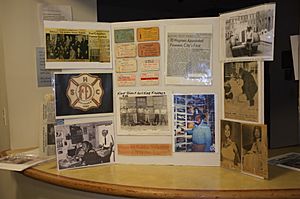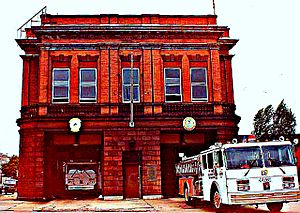Arthur "Smokestack" Hardy facts for kids
Quick facts for kids
Smokestack Hardy
|
|
|---|---|
| Born | April 2, 1901 Baltimore, Maryland, United States
|
| Died | December 4, 1995 (aged 94) |
Arthur "Smokestack" Hardy (born April 2, 1901 – died December 4, 1995) was a very special person. He was a volunteer firefighter, a photographer, and someone who loved collecting things about fire history, especially about African-American firefighters. He was the first African-American firefighter in Baltimore, Maryland. Today, there's a museum in Baltimore with his amazing collection, and a fire station is named after him!
Contents
Who Was Smokestack Hardy?
Early Life and His Nickname
When Arthur Hardy was just three years old, he saw the huge Great Baltimore Fire in 1904. He watched it from his grandmother's roof. This big event really shaped his life and made him love firefighting.
As a kid, he would run alongside the fire engines. These old engines had short, black smokestacks on top. Because he loved watching them, the firefighters gave him the nickname "Smokestack." This nickname stuck with him his whole life!
Becoming a Firefighter
During World War II, Baltimore needed more firefighters. This led to the Baltimore Fire Department allowing African-American firefighters to join. In 1942, Arthur Hardy became one of the first fifteen recruits to the Auxiliary fire department. He was the first African-American firefighter to be officially certified in Baltimore.
The Civil Defense program trained these black volunteers. They helped firefighters all over the city. Arthur Hardy also served in the Army during World War II for six months. He was honorably discharged in 1943 because he was older. Later, he worked as a janitor at Johns Hopkins University.
Fighting for Fair Treatment
In 1949, Arthur Hardy started the SHC Fire Buff Club. SHC stood for Smith, Hardy, and Carter, who were friends and fellow fire enthusiasts. They worked hard to get paid positions for auxiliary firefighters. Arthur Hardy was the last living member of this group.
In 1953, the first 10 paid black firefighters were hired after passing a Civil Service exam. Joining the fire department was not easy for these early recruits. They often faced unfair treatment. For example, they shared only two beds at the firehouse and had to bring their own kitchen tools. They were often left out of activities with the white firefighters. Despite these challenges, more black firefighters joined in the years that followed.
Arthur Hardy loved his passion for firefighting history. He had special "pass cards" from many different fire departments. These cards allowed him to go behind fire lines to take pictures of fire scenes. The auxiliary firefighters were officially supported by the fire department. They even had a working replica of a call board. When a major fire alarm was called, they would help by setting up ladders and directly fighting fires.
Smokestack's Amazing Collection
A Passion for History
Smokestack Hardy was unique because he loved collecting everything about fire history. He was especially interested in items related to black firefighters. He wrote letters to people all over the country and even around the world. Almost everyone in the fire service knew him and received his letters.
Mostly, he wanted to find out where the black firefighters were located. He wrote so many letters and carefully dated all the replies he received. He filled many black binders with these letters in his home in West Baltimore. It is said that he knew every black fire chief in the country! He followed the careers of firefighters in over 500 cities.
A new book about the struggles of firefighters becoming integrated mentions one of his letters. This letter was sent in 1941 to Battalion Chief Wesley Augustus Williams of the FDNY Vulcan Society. Another fire enthusiast, Mike Legeros, created a special section for Smokestack in his online history of black firefighters. He even noted Smokestack's unique system for acknowledging replies (month-day-year).
A Living History Book
Smokestack Hardy saw the history of firefighting change a lot. He saw it go from horse-drawn steam equipment to modern motorized vehicles. When the IABPFF was formed, he was asked to be the main historical expert on black firefighters.
He filled his house with items that firefighters sent him. There was so much stuff that a visiting reporter couldn't even find a place to sit during an interview! Documentaries were made where he played a big part. He was featured twice in Ebony magazine. In 1954, the Negro History Bulletin by Carter G. Woodson called him "A Real American Fire Fan."
When he passed away, he was known as one of America's greatest fire enthusiasts. The Baltimore fire department even named a firehouse after him. In 2004, Engine Company No. 13 and Truck Company No. 16 on McMechen Street was renamed The Arthur "Smokestack" Hardy Station.
After he died, he passed his collection to a new generation of fire enthusiasts. One of them was Guy Cephas, an auxiliary firefighter who had been mentored by Hardy. Guy Cephas, along with a board of directors, now runs the museum. It is open two days a week and by request.
The Arthur "Smokestack" Hardy Fire Museum
Finding a New Home
The museum started in the front room of Guy Cephas's home. Guy Cephas is currently working with the Baltimore City Council to find a bigger space for the museum. He is also looking for grants to help fund the move.
On January 29, 2015, the Baltimore Housing department took a step towards the museum's preferred new location. They approved a plan to renovate 1220 E. Oliver Street for the African American Firefighters Association. This building is a very important former firehouse in the Oliver neighborhood. If they get enough funding, the association plans to create a working museum there and fix up the old building.
Over the years, many elementary school groups, clubs, and churches have visited the current museum. Guy Cephas hopes for an expanded museum so he can display many more artifacts that are currently in storage.
What's in the Collection?
The museum has many amazing artifacts. These include:
- An alarm gong (a bell used to signal alarms)
- Call boxes (old devices used to report fires)
- Signs
- Hoses
- Photographs
- Models of fire engines
- Lanterns
- Bells
- Water buckets
The collection also includes copies of newspaper articles, photo prints, helmets, badges, calendars, letters, and fire patches from departments all over the world.
As of September 30, 2019, the collection is housed at the Fire Museum of Maryland. They are looking for funding to catalog and digitize the collection. This would make it available and searchable online for everyone to learn from. The Fire Museum of Maryland was started in 1971 and is located at 1300 York Road in Lutherville, Maryland.



